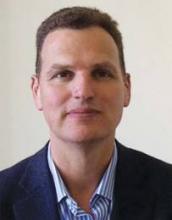Ustekinumab at 45-mg and 90-mg doses significantly improved arthritis symptoms, physical function, and inflammation in adults with psoriatic arthritis, compared with placebo, after 24 weeks of treatment, according to findings presented by Dr. Iain B. McInnes at the annual European Congress of Rheumatology.
These findings come from the PSUMMIT I study, a multicenter, randomized trial of 615 patients. Participants were patients whose psoriatic arthritis (PsA) remained persistent, despite treatment with NSAIDS or disease-modifying antirheumatic drugs (DMARDs). They were randomized to 45 mg of ustekinumab, 90 mg of ustekinumab, or a placebo. Patients who had been treated with anti–tumor necrosis factor (anti-TNF) agents were excluded from the study.
After 24 weeks, approximately half of the patients in the 45 mg–dose (42%) and 90 mg–dose (50%) groups achieved an ACR 20 response (that is, a 20% improvement based on certain parameters specified by the American College of Rheumatology); the percentages for both groups were significantly greater than that of the placebo group (23%).
"These findings are in line with our expectations from the original phase II trial published a short number of years ago and with the success already enjoyed in using this medicine in treating the skin component of the psoriasis/psoriatic arthritis spectrum," said Dr. McInnes, director of the Institute for Infection, Inflammation, and Immunity at the University of Glascow (Scotland). The findings are also gratifying, he added. "There has been some evidence elsewhere to suggest that the cytokines that are targeted by ustekinumab might be of importance in psoriasis and psoriatic arthritis pathogenesis – these clinical data are compatible with those ideas," he noted.
Significantly more patients in both ustekinumab groups achieved ACR 50 and ACR 70 responses, compared with the placebo patients. In addition, ustekinumab patients had clinically meaningful changes from baseline Health Assessment Questionnaire Disability Index scores (defined as a change greater than or equal to 0.3), compared with placebo patients. Approximately twice as many patients in the two treatment groups demonstrated this change, compared with the placebo patients (48% vs. 28%, respectively).
The median change in enthesitis scores were 43% in the 45-mg ustekinumab group and 50% in the 90-mg ustekinumab group, compared with no change in the placebo group.
So far, no substantial differences in adverse events between the treatment and placebo groups have emerged, Dr. McInnes said in an interview. However, "this is a small trial – in comparison to the larger phase III and postmarketing datasets for this agent in the psoriasis field – and as such we need to be conservative in our interpretation of adverse events," he emphasized. "Continued vigilance will be the key here, and follow-up is ongoing," he said.
If the findings are confirmed in other studies, "we may be able to offer this agent to provide a new mode of action for the treatment of psoriatic arthritis, a disease for which we currently have too few options available," said Dr. McInnes. However, "it is too early to determine at which stage in the patient journey such use would be optimally employed," he said.
"It seems self-evident that use of ustekinumab would be after conventional drugs have been tried, and then, most likely it would be used after a TNF inhibitor because that has been the order of discovery. This reflects the RA treatment paradigm.
"But this might not be the best course; in fact, we might get similar results with different modes of action. So without head-to-head data we would make our decision based on the extent of safety data available. There is considerable safety evidence for ustekinumab in the skin literature; however, right now there is a challenge to work out where this drug will be used if it is marketed" said Dr. McInnes.
Approximately half of the patients were using methotrexate at baseline, but this did not impact the effect of ustekinumab vs. placebo.
Dr. McInnes reported financial support from Janssen Research and Development.


